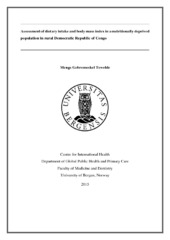| dc.description.abstract | Introduction: In the Democratic Republic of Congo (DR Congo), about 70% of the total population and more than 40% of children under the age of 5 are undernourished. In such an area, assessment of nutritional adequacy is vital as it can provide valuable data for policymakers that can be used for advocacy to focus on particular problems that need to act on. Thus, this cross-sectional study aimed to assess nutritional adequacy of diet and body mass index (BMI) in a nutritionally deprived population in rural Bandundu Province in the DR Congo and compare our findings to other African studies by doing a literature review. Methods: Dietary intakes of 76 subjects from 12 systematically selected households were collected using 3 days weighed food records. The weights of food consumed by individuals were converted in energy and macronutrients using relevant food composition tables. The individual intakes and energy percent from macronutrients (E%) were assessed for adequacy by comparing with the recommended intakes and acceptable macronutrients distribution ranges (AMDRs), respectively. Weight and height data were also collected from 440 adults using calibrated equipment and standardized techniques. The WHO BMI cut-off points were used for assessment. To investigate the socio- demographic factors associated with being underweight, logistic regression was used. A semi- systematic review was adopted to search for relevant published articles. We searched 3 online electronic databases, 4 online journals, 5 authors and the reference lists of the identified key articles. Then the findings of the selected articles were compared with our study findings. Results: Protein and fat intakes were below the recommended intakes in all age groups, in spite of energy intake being adequate. The E% from protein and fat were both far below the lower limits of the AMDRs. The diet was highly monotonous, dominated by cassava, approximately 80% of the participants energy was derived from cassava. Comparing this finding with other African studies, our participants had the most monotonous diet of all the free-living African populations. Based on the BMI assessments, 47% of the overall adults were underweight, 52% were in the normal weight range and 1% were overweight. Using logistic regression model, we found significant association with underweight status and participant's age, but not in sex or residence village. Comparing these figures with other studies in Africa, our study reported one of the thinnest free-living adult populations in Africa. Conclusion: This study revealed an extremely monotonous diet and a high prevalence of underweight. Therefore, immediate nutritional interventions are warranted to alleviate the current problems. In long term perspective, efforts to enhance agriculture diversity, empower the economic development and enrich the diet with animal products should be considered. | en_US |
